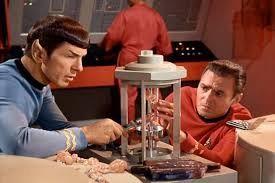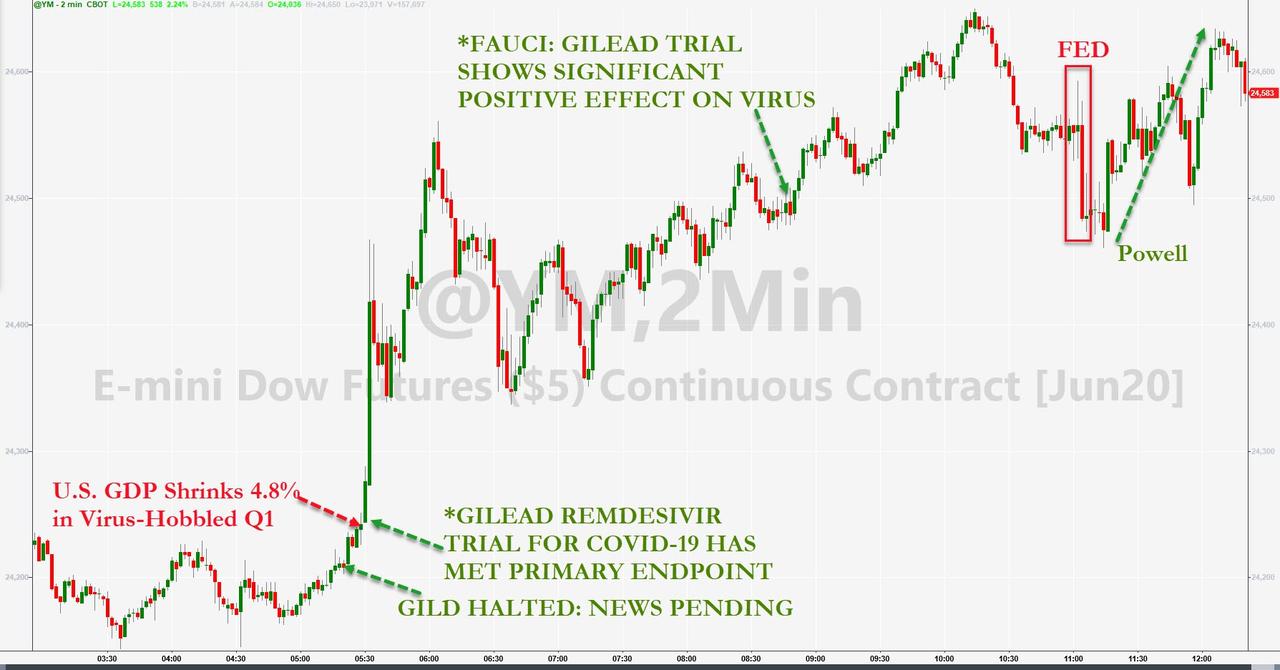Rabobank: Is It A Coincidence That The Good Virus News Came At The Same Time As The Catastrophic GDP Release

Apologies in advance, but readers who have never watched any Star Trek might find some of the analogies used today rather confusing: then again, the classic original series is out there on Netflix and we are all mostly locked-down, so…
Markets are currently accelerating in risk off mode, with USD reeling. Part of that is end-month positioning and momentum, but it's happening even against traditionally wobbly FX like Indonesia's IDR, and even when Indonesia is outright monetising public debt and running out of food staples in some areas. Like TV science-fiction, just press the buttons, go with the ride, and don't ask too many questions(?)
The other major reason for the swing in sentiment is the Fed, which as Philip Marey notes, while making no major changes yesterday also underlined it is committed to using its full range of tools forcefully, proactively, and aggressively. Chair Powell said it may very well be the case that the economy needs more support from "all of us" (so monetary and fiscal policy). The engines are in in fine fettle, says Scotty.
Yes, there was the wrinkle that Powell also said that the law (Section 13-3 of the Federal Reserve Act) gives the Fed lending powers, not spending powers, so the Fed cannot lend to insolvent companies, and therefore the special lending facilities will remain (mostly) aimed at companies that can repay their loans. This suggests dangerous cracked dilithium crystals. Yet will the Fed really be asking too deeply if companies can pay their loans or not in a collapsing economy, or will it just use optimistic projections to assume that they will be able to? After all, that's what the IMF does in many key cases, so it's hardly changing the 'laws' of market 'physics'.
And then there was virus news. First, Dr Fauci, the health expert who the world is listening to daily (the same Dr Fauci who in February said Covid-19 risks to the US were very low) announced that as far as he is concerned, the experimental new drug Remdesivir presents "quite good news" and could get emergency FDA approval in days. This is the same drug a Lancet report says failed recently in another location.
Then President Trump announced "Operation Warp Speed". No, this is not related to Spaaaaace Foooorce (which I politely remind readers must only be said into one's cupped hand). Rather we will see a Manhattan Project-style US effort to develop a vaccine at the fastest possible pace, uniting pharma companies, government agencies, and the military. Together this will see multiple vaccines developed at once, with the least successful dropped at each stage. Risk will be underwritten by the government not the companies to encourage them to go all in. The aim? To have 100 million doses of virus vaccine ready by year-end.
This is undoubtedly positive given the clear logic that until we get a vaccine we cannot emerge from this crisis. Markets are right to see it as great that the US is pushing ahead with the kind of war-time all-of-government approach that so far has only been hinted at via limited flirtation with the Defence Production Act. We need the president to play Captain Kirk and shout "Warp speed!" (or Jean-Luc Picard and say "Make it so." – but the questionable hair and hammy acting says Kirk to me). It's certainly far preferable to the President acting like Harry Mudd and dragging us into the mud of who said what about ingesting disinfectant and why. However, two major caveats:
One - this still does not mean Operation Warp Speed is going to work. The more money thrown at a problem does not always mean the quicker a solution is found, if at all. That said, what I hear from scientists--who traditionally live on crumbs as the money usually flows into tech companies designed to destroy employment and wages while losing money--is that we can at least now give it a real try. Yet in the interim the economic damage continues to pile up.
Two - is it a coincidence that the good virus news from the White House came at the same time as Q1 US GDP was -4.8% q/q annualised, even weaker than the -4.0% expected? Indeed, given January, February, and parts of March were business as usual in much of the US, one can now start to project how horrendous Q2 damage is going to be. Let's just say that the risks are the Fed will have to make some true science-fiction forecasts to keep lending to only solvent companies. Notably, despite the surge in stocks and sell-off in USD, 10-year US Treasury yields are not even moving on impulse engines, let alone warp speed.

Meanwhile, if the White House is now the bridge of the (State-Owned) Enterprise, some of the crew are looking for 'Klingons' to rumble with. Secretary of State Pompeo continues to single out China for criticism, stating Beijing has not been forthright on the virus and that the Chinese Communist Party will be held accountable by the US; Captain Trump, largely unreported by the financial press, last week said China may have to pay reparations of USD160bn. The two attacks have obviously sparked a furious Chinese response - and their shields are well and truly up. Yet the US may be about to fire photon torpedo: a group of bipartisan US lawmakers are urging Pompeo to address China's recent actions in Hong Kong in the upcoming certification of the Special Autonomous Region's status, which must be done by 25 May. Nobody is sure what that means, but the backdrop points towards a bridge-hit on US-China relations. So risk off? Or does this no longer matter now Fed Funds are at zero, and that was the whole point of trade-war market wobbles in recent years?
As the US and China circle each other in space, Beijing is still trying to show that is has sustained only minor damage. Today's PMIs for April showed manufacturing at 50.8, down from 52 but growing again, despite stories reporting mass unemployment and restrained consumer demand. Services were at 53.2, up from 52.3, despite cinemas being shut, gyms in Beijing being closed, and life existing under a new normal. The Caixin PMI, which covers smaller businesses, was 49.4, down from 50.1, and paints a less flattering picture of an economy in what would in normal times be called a slump.
Australia likewise saw private credit leap 1.1% m/m in March vs. 0.3% expected, but this was firms drawing down loans for the lockdown period. We aren't back to Aussie borrowing at warp speed yet – although the powers that be would like it to happen. New Zealand, however, saw an uptick in final April business confidence to the ominous -66.6 from -73.1. Again, better, from a staggeringly-low base.
Commenti
Posta un commento